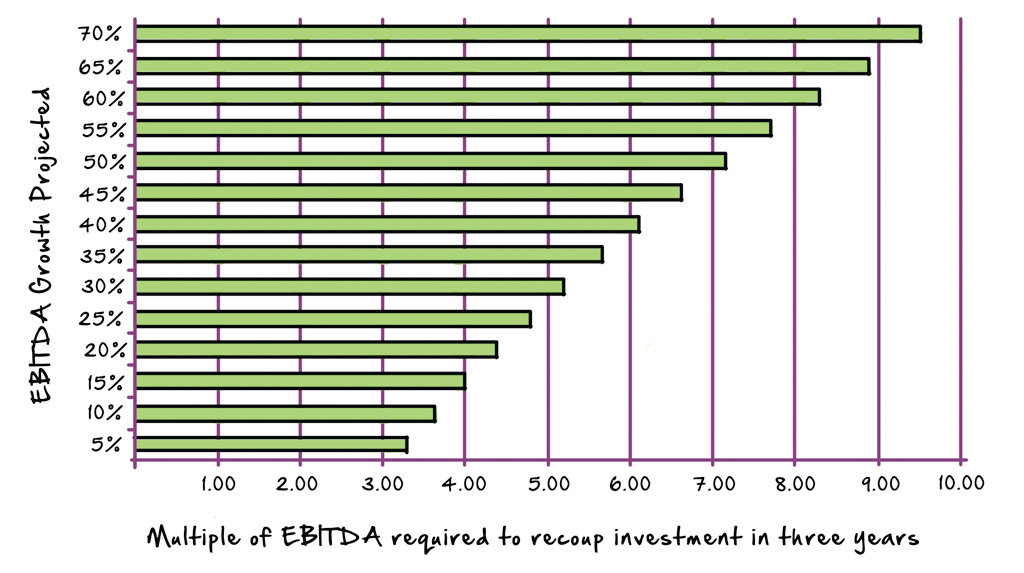How to value a professional services business
How to value a professional services business …
Fundamentals, fundamentals, fundamentals.
You’ve got to get the fundamentals down because otherwise the fancy stuff isn’t going to work.
Randy Pausch
A cautionary foreword …
This article dwells on the topic of value specifically as it refers to the financial price a buyer would be willing to lay out for your company in the future. Helping you to understand this is an extremely important step in the context of a blog series that seeks to guide its readers to a stage when such value has a real, potentially life-impacting, quality. That said, I am conscious that what I am about to describe can come across as somewhat sterile, financial or just a bit too self-obsessive about internal matters. Little mention is made of the work you do, or the clients you serve.
For the complete absence of doubt, therefore, let me make one point abundantly clear before we set off. All this talk of your own value is for nought if you are not primarily obsessed with, and successful in, delivering tremendous value to your clients in whatever services you offer – as gauged by them. In order to even get started on this topic, I have to assume that this is your foundation. With that important point made, let’s get going …
There are a number of valuation methods used to value companies generally – ranging from asset valuation, liquidation or book value, the modelling of future income streams through to industry-specific ‘rules of thumb’.
When it comes to professional services businesses, however, one viewpoint comes to the fore. Simply put …
Valuation is driven by the expectation of future profit.
That is, a buyer is primarily interested in the total amount of ‘Owner Benefit’ they can extract in the future based on a business’ historical trading performance and its current organisational capabilities. As such, the most common valuation method is a variant of:
Profit x Multiple
Typically, the value used for profit in this equation is:
EBITDA x Multiple
Where EBITDA stands for ‘Earnings before Interest, Tax, Depreciation and Amortisation’. In reality, there is often little by the way of asset depreciation and amortisation in a typical professional services firm, so you will also see common reference to the simpler EBIT (‘Earnings before Interest and Tax’) variant.
Analysts will also look at ‘top line’ revenue multiples, but this is done typically as a crude proxy when they suspect that the reported earnings figures are not an accurate representation of the actual levels of ‘discretionary cash flow’. For example, the owner of a business may take some of the discretionary cash flow out in the form of a bonus – above the profit line – and hence artificially depress a reported EBITDA figure. This, in turn – from the perspective of an external analyst reviewing a company’s purchase price – could lead to a very high EBITDA multiple. What they are not privy to is the adjustments often made to reported EBITDA figures, in the course of such negotiations, in order to bring them back in line with normal treatment. As such, aware of this blind spot, analysts often examine the revenue multiple of a reported sale price also – as this ‘top line’ figure is clearly less susceptible to such tinkering.
In relation to your business, however, a typical sale value discussion will involve the buyer getting access to a true, or normalised, EBITDA figure (for the last twelve months) and then a critical negotiation around the firm’s EBITDA multiple will ensue.
Let’s pause there because this is important.
One simple way of looking at this, is that the multiple is the number of years a buyer would have to own the firm in the future, trading at its current level of profit performance, before their purchase outlay is paid back. A buyer is, however, not expecting static growth and, indeed, you are very unlikely to be engaged in such a negotiation if your company is not on a clear profit growth trajectory. Rather, the multiple, therefore, is an indication of the quality of the company’s trading capability. Understanding how this quality attribution is made up in the mind of the average buyer is absolutely critical.
Another way of coming at this, from the perspective of a buyer financier, is as follows. A typical buyer will seek to recoup their outlay in, say, three to five years. Let me assume, prudently, that you will end up negotiating with a bullish buyer who seeks to recoup the investment in three years. Based on your historical EBITDA growth figures (and perhaps their ability to make even greater gains through cross-efficiencies) they will project the EBITDA that will be produced, post-acquisition, over this period. And, this figure is what they are willing to pay now. Dividing this by your current EBITDA is, therefore, the effective multiple they are willing to pay based on this payback horizon. By example, from the chart below, if your EBITDA is growing at 30% per annum, such a buyer would countenance paying a five-times multiple.

Illustrative EBITDA multiples a financier would be willing to pay based on a three-year payback period (against a range of projected annual EBITDA growth rates)
This is a pure financial analysis, based on an arbitrary (but typical) payback period; notwithstanding, you should be aware that an analysis of this type will certainly have a key place in the negotiating buyer’s mind.
There is another axiomatic point to be drawn from this. In that your objective is to maximise this compound value, but your management time is finite, on what side of the ‘EBITDA x Multiple’ equation should you focus (or is it just a case of even distribution)?
Well, of course, growing EBITDA is a priority. You will not even get to be in the game if you can’t demonstrate this management record. But, and it is a big ‘but’, within parameters. As soon as you are achieving healthy levels of year-on-year profit growth (say 20% or greater), you are very likely to be better off deliberately skewing your time and effort towards the ‘Multiple’ (or quality) aspect as far greater gains to overall value can be made here.
To illustrate, consider a business that is making $1m of EBITDA and advancing well at, say, 20% EBITDA growth per annum. In terms of its business infrastructure, and qualitative assessment, let’s just say a buyer would value it as a 5 x EBITDA company. Next year, therefore, if growth continues on track, the company could be worth $6m ($1.2m x 5). If the owner really ‘bust a gut’ on the profit growth side (achieving 30% EBITDA growth), maybe they could get this to $6.5m ($1.3m x 5). Suppose, however, that growth rates were held and managerial effort focused more on improving the qualitative aspects of the firm – thus moving the buyer’s multiple offer to 7 x EBITDA or an $8.4m business? You get the point?
Clearly this is a simplification but it is a really useful one to make at the heart of everything you do. Once healthy profit growth is established, you will need to focus on developing the elements of the business that make this sustainable; that improve your qualitative value in the eyes of a potential buyer. You will only be able to grow revenue and profit so fast (indeed, you may damage your business by growing too quickly) but you can make significant strides in the more elastic aspect of your company’s multiple value with focused attention to this aspect.
Understanding this point, and having an awareness of the components that make up this qualitative multiple, is – therefore – critical to your future business success.
Closing cautionary note …
If the previous section touched on what ‘value’ is in the context of a professional services firm, it is really important – conversely – to be aware of what it isn’t.
The value of your business has nothing to do with how long you have been trading per se; only how long you have been trading in profitable growth. It also has nothing to do with the potential ego-trappings of running a business; for example, how many people you employ or how large and shiny your office is.
Finally, it has nothing to do with how hard you are working or have worked historically. If only there was always a direct correlation between hard work and value generation, the world might seem a fairer place. The truth is, however, that the vast majority of business owners are working hard; it is just that this needs to be coupled with smart stratagems and decisions that actually impact the value equation just described, for this effort to be relevant.
Another aspect you should really guard against is a revenue growth line full of ‘peaks and troughs’. Potential buyers will be very wary of this as it tends to point to a company with a small portfolio of clients (and the vagaries of their on/off purchasing decisions).
—
So, by healthy profit I mean steady, consistent growth that is a function of a growing client diversification.
—————
————
If you are interested in re-charging your business ambition/strategy/plans, Dom runs his (three-day) Five-Year Entrepreneur Retreat twice a year (March, September) – see here for previous delegate testimonials and details on future presentations. If you would like to make a reservation (capped to 14 attendees per Retreat) please drop a line via the contact page.




Hi Dom, useful stuff. I’ve recently written an article on what creates value in service firms (which – ironically, given I have a background in finance – contains no numbers at all). I’m interested to know what you think: http://www.f-works.co.uk/building-your-service-business/service-business-machine-part-3-the-importance-of-predictability/